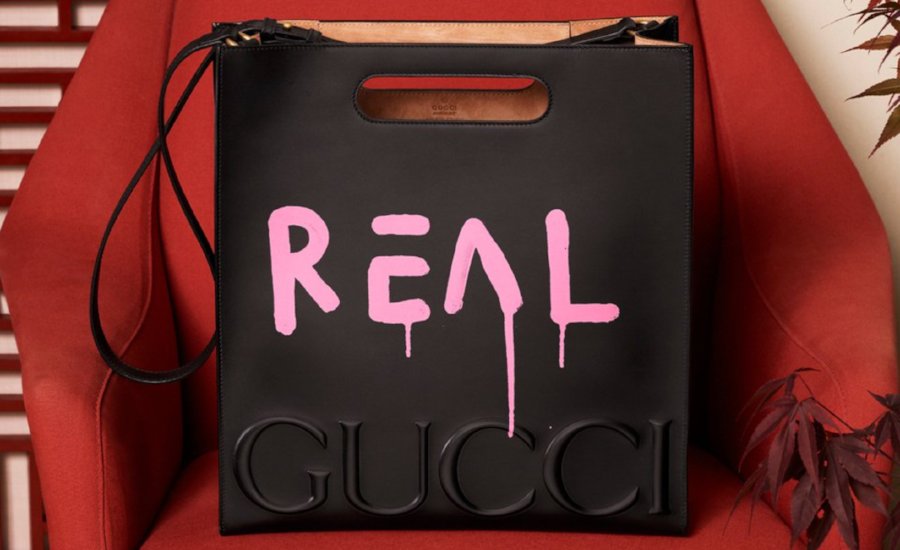
image: Gucci
Fresh on the heels of announcing that it had managed to settle the second counterfeiting lawsuit that Gucci’s parent company Kering has filed against it in the past five years, Alibaba Group Holding, China’s largest e-commerce firm, reported first-quarter revenue above Wall Street estimates, with help coming from “the strength in the Chinese e-commerce market and more Chinese consumers buying an increasing proportion of everything from food to clothing to luxury items online,” per Reuters.
Continuing its seemingly endless growth streak, Alibaba’s revenue rose a whopping 56 percent to 50.18 billion yuan ($7.52 billion) for the three months ending on June 30. “Revenue from its core e-commerce business [which accounts for 86 percent of total revenue for Alibaba for this quarter] rose 58 percent, just shy of the 59.5 percent jump in the previous quarter,” Reuters reported on Thursday.
Its revenue from digital media and entertainment ventures increased 30% year over year to $602 million. As for Alibaba’s cloud computing services, revenue grew 96 percent in the quarter to 2.4 billion yuan ($3.6 billion), with total paying customers breaking the 1 million mark for the first time, up from 577,000 this time last year.
“Our technology is driving significant growth across our business and strengthening our position beyond core commerce,” Alibaba CEO Daniel Zhang said in a statement.
Alibaba v. Amazon
As for the question on many peoples’ minds when discussing Alibaba’s growth and revenue figures: How does it compare to its western equivalent, Amazon? One easy, go-to point of comparison pits Alibaba’s Singles’ Day against Amazon’s Prime Day, a battle in which there really is no competition. Last year, Amazon’s Prime Day – a one-day shopping event that takes place each July for Amazon Prime members and has been dubbed the new Black Friday – brought in a reported $415 million in sales, per CNBC. Sales for this past July’s Prime Day were up 60 percent, according to a statement from Amazon.
Retailers on Alibaba’s platforms, on the other hand, recorded $17.8 billion in sales on Singles’ Day. (Note: Singles’ Day, which was first celebrated in the 1990s by young, single Chinese as an anti-Valentine’s Day, was co-opted by Alibaba in 2009, as a means of boosting revenue in the traditionally quiet sales period before the Lunar New Year season).
Meanwhile, out of the two, no shortage of industry analysts are betting on Alibaba. Seeking Alpha’s Jonathan Weber, for one, says: “Alibaba once again showed great growth during the first quarter, and unlike its bigger rival Amazon, Alibaba is growing very profitably.”
Weber goes on to note, “Alibaba is active in the same industries as Amazon (cloud, online retail, digital entertainment), and has significantly higher growth rates in those areas. On the other hand Alibaba’s total revenues are a lot smaller than Amazon’s total revenues, which makes it even more surprising that Alibaba is so much more profitable.”
Sites Filled with Fakes
On the counterfeiting front, there is no way around the fact that both sites are rife with fakes and facing lawsuits – and in some cases, filing lawsuits – as a result. Alibaba has long come under fire – with luxury brands and the U.S. Trade Representative, alike – for its failure to stamp out the truly exorbitant number of counterfeit goods on its platforms.
Amazon, on the other hand, was, for years, almost exclusively home to authentic goods, but has seen a marked uptick in the availability of fakes since it decided to allow Chinese sellers to list their products directly on its platform, rather than requiring them to go through domestic importers – a move that has been viewed largely as a defensive strategy against Alibaba.
As Cory Doctrow noted in an article for BoingBoing this time last year, Amazon’s “older model was less efficient at getting Chinese goods to western customers, but it was also an important filter for counterfeits, because the domestic importers were easier to track down and punish for the worst offenses.”
The influx of counterfeit sellers on these online marketplace platforms is exacerbated by the failure of their owners/operators to eliminate rampant sales of counterfeit goods, either due to willful negligence tied to the desire to profit from these sales or failed efforts to reduce them – or still yet, the ability of counterfeit sellers to thwart the sites’ existing anti-counterfeiting measures. This proliferation of counterfeits – many of which look exactly like and are priced quite similarly to the real things – has thus contributed to increased consumer uncertainty, at least when it comes to Amazon.
In short: the waters are murky and consumers are often rightfully misled on both platforms. So, on this account, they are likely equal but for the fact that Alibaba simply has so many more sellers – 10 million active sellers to Amazon’s 2 million – and with that comes a whole lot more fakes.










